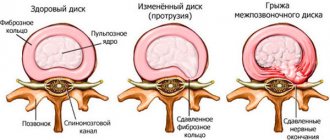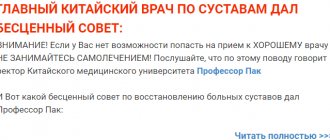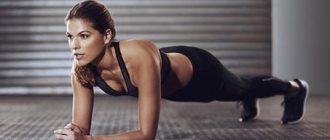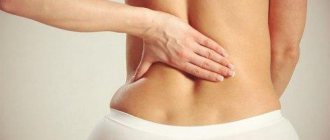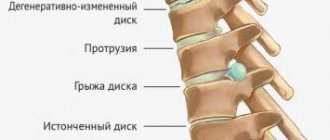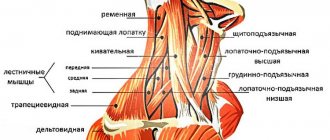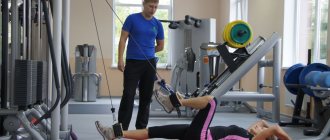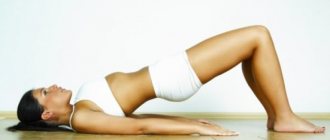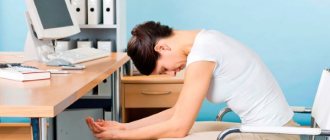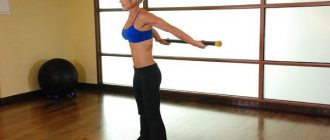| more than 500 comments | more than 500 thousand views |
Why medals are given to articles:
| Bronze medal: | |
| 1. The article is in the TOP 100 2. The article has more than 3. The article has more than 100 | |
| Silver medal: | |
| 1. The article is in the TOP 50 2. The article has more than 3. The article has more than 500 | |
| Gold medal: | |
| 1. The article is in the TOP 10 2. The article has more than 1 3. The article has more than 1,000 | |
Intervertebral hernia is a deformation of the intervertebral disc with its protrusion by more than 3–4 mm.
There are several types of hernias. Frontal, lateral, sequestered, Schmorl's hernias and (the most dangerous) paramedian. As we said above, the greatest danger for an athlete and for a person not involved in sports is a paramedian hernia, since it is directed towards the spinal cord root and can compress it, which causes the so-called “radicular syndrome”. This violation of the integrity of the intervertebral discs can be caused by various factors: poor diet, sedentary lifestyle, and poor training. I would like to note that intervertebral discs, like the vertebrae themselves, do not have nerve endings or receptors. Therefore, they cannot cause pain. And the pain that a person experiences with this pathology is most often caused by a spasm of the spinal stabilizer muscles (deep back muscles). For example, such as the short and long rotator muscles and the multiprocess muscle. These muscles go into spasm due to the fact that, as a result of the disease, the stability of the spinal segments is disrupted. As a result, the muscles have to perform their compensatory function to a much greater extent than usual. Therefore, they get tired and go into a state of spasm.
https://youtu.be/2wK-XTeDtWM
In this case, the main task of training and treating a hernia/protrusion is to remove the muscle from spasm and train it to cope with this load. This may take up to several months. In your workout, it is enough to include several different exercises aimed at the problem area, with moderate weights, 12-20 repetitions per approach. After class, it is advisable to stretch the body part being worked on.
The range of exercises for this pathology depends on many factors. Such as age, gender, physical development, psychological characteristics of the patient’s personality. It is especially difficult to relieve pain in trained people, since a well-developed muscle corset does not allow access to the deep muscles (trigger zone). We must understand that axial loading exercises can be an aggravating factor.
Therefore, the main principle when exercising with a hernia and protrusion is the complete exclusion of axial loads on the spine (barbell squats, deadlifts), as well as exercises that cause acute pain. In addition to hernia treatment methods such as massage and stretching, it is advisable to perform the following exercises:
- Abdominal exercises (torso twists, leg lifts). It is recommended to perform with maximum amplitude to better stretch the back muscles.
- Bending over a goat (hyperextension).
- Wide and narrow grip pull-ups.
- Rows from the upper block behind the head, to the chest, with a narrow grip and rows of a horizontal block. When pulling a block horizontally, you can use a forward bend to better stretch the back muscles. But the tilt should be carried out with a straight back and head thrown back, which will better stretch the muscles of the lumbar region.
- It is better to do the bench press without a bridge, and also, if possible, avoid long-term static positions in everyday life (sitting, standing), since static work of the back muscles provokes spasm.
- Exercises for arms and shoulders can be done without restrictions, except for exercises with axial load (seated and standing barbell presses and dumbbells).
- Exercises such as shrugs and dumbbell swings to the sides are best done while sitting with your back supported at an angle of 70 - 80 degrees.
All strength exercises for a hernia must be performed with extreme caution, as in some cases they can lead to even greater spasm.
In my practice, many active professional athletes who have intervertebral hernias do not experience pain due to well-developed muscles. This is true even for sports veterans. If you are involved in one of the strength sports, then do it constantly, without long breaks and competently, this will help you avoid health problems and will contribute (as far as possible) to the treatment of a hernia or protrusion.
Found an error in the article? Select it with the mouse and press Ctrl + Enter . And we will fix it!
Benefit
How can physical therapy help with a herniated disc in the lower back? Of course, it will not be possible to completely repair a spinal hernia. Herniation cannot be cured using conservative methods. However, regularly performing a set of special exercises will help achieve a positive effect.
What are the benefits of exercise therapy for vertebral hernia:
- Exercises help strengthen your back muscles. Thanks to the restoration of the muscle corset, pathological displacement of the vertebrae during sudden movements or high physical activity can be avoided. Reducing the incidence of pinched nerves is an additional benefit.
- Gymnastics helps increase the space between the spinal discs. Stretching exercises will increase the distance between the vertebrae and reduce pressure on the deformed disc. Increasing the space between the ridge cartilages in some cases even helps reduce the size of the hernia.
- Normalization of nutrition of paravertebral tissues and vertebrae. If you choose the right exercises for lower back pain due to a hernia, you can achieve improved blood supply to the intervertebral cartilage, nearby muscles and ligaments. Increased blood flow also helps partially restore damaged cartilage.
- Normalization of the functioning of the mobility of the spinal column. This is especially important when the damage concerns the cervical-collar area and the lumbar region. It is these parts of the spine that are the most mobile, which is why vertebral subluxations occur with displacement and compression of blood vessels.
Exercises for a hernia in the lower back do not require special physical training. You just need to allocate some free time to do the exercises.
Hernias and bodybuilding. How to exercise correctly and is it necessary?
My respect, ladies and gentlemen! It’s Friday on the calendar, which means it’s time for a note from our “Patient’s Corner” section, and today we’ll talk about the topic “Hernia and bodybuilding.”
After reading, you will learn everything about this acquired disease - how it forms, why, what effects it leaves on health, we will also figure out how to properly train for hernias, which exercises should be avoided and which ones to use.
So, take your seats in the auditorium, we are starting.
Hernia and bodybuilding: FAQ questions and answers
Well, I would like to start this note with a familiar statement to all of us: “do no harm.” Indeed, few people talk about the other side of the medal of strength training, but it is quite unpleasant. Often, instead of improving one’s health, when a person comes to the gym, he ruins it.
And okay, he’s ruining it himself, as they say, my health, I do what I want, but more and more often a third-party specially trained person takes part in the process, meaning a trainer.
It’s exactly this kind of letter: “help me, what should I do now” that I’ve started receiving lately in the project’s email.
Readers share their first unsuccessful experience of going to the gym and the appearance of sores that they did not have before. Sometimes a person decided to simply tone his muscles in order to become more fit and shapely, but in fact he developed a protrusion or herniation of a spinal disc. Those.
We came to the gym to improve our health, but we leave it with a serious (for life) illness, which affects the comfort of life. Of course, after such abuse of one’s health, a person loses all desire not only to go to the gym, he is jarred by the very word healthy lifestyle.
The first negative experience of training in the gym leaves an indelible mark on the life of a novice athlete and, moreover, can forever discourage him from various types of fitness centers and gyms to change himself.
With this series of notes, and we already have articles such as scoliosis and bodybuilding, arthrosis and bodybuilding and others, we will try to convey information about how to train if you already have any serious illness, and what measures are necessary to take to prevent it. In continuation of this post we will talk about hernias and bodybuilding.
Note: For better assimilation of the material, all further narration will be divided into subchapters.
Spine - instructions for use
When coming to the gym for the first time, the most common thing a beginner can hear is: “do the basics!” Without bothering to find out whether the athlete has any health problems, diseases or limitations, he is put on the base.
This is the wrong approach and can be harmful to the health of a beginner. Basic exercises are some of the most difficult to coordinate, and to work with them you need to have a pumped up “brain-muscle” channel, i.e.
so that all stages of the movement are performed synchronously, and the load is pulled by the proper muscle units.
Therefore, placing a newcomer (regardless of gender) on base is a sure way to ruin him. No one will look after your equipment for free, and you simply cannot know it yourself, because... The decision to go to the gym came spontaneously, and you didn’t spend months at home studying videos/books on exercise techniques.
https://youtu.be/vfq526Nzvxk
When getting to the base, for example, squats with a barbell or deadlift, we expose our fragile spine to loads that are unusual for it, the slightest violation of technique and hello... “oh, something shot inside me.”
The spinal column consists of several sections formed by a corresponding group of vertebrae, each of which is responsible for a particular organ/part of the body and symptoms if it is incorrectly positioned or displaced.
When you initially come to the gym, you most likely already have spinal curvature, scoliosis or other forms of it, coupled with weak back muscles, in particular the erector spinae. There is a high probability of a back breakdown and a negative impact on the intervertebral discs. All this can result in the following spinal disorders.
The most common types of spinal disorders are changes in posture - kyphosis, lordosis, scoliosis.
Working with weights leads to compression of the intervertebral discs, irritation of the nerves and the occurrence of protrusions and hernias.
When working with basic exercises, the spine experiences colossal overloads, a minimum of 60 kg when working while standing and up to 730 kg when bending and lifting weights from the floor.
95% have them to one degree or another ), can result in an event called “I’ve done it, what should I do now?” "
Disc protrusion: what is it?
Sometimes doctors diagnose disc protrusion, and some equate these concepts: hernia = protrusion, this is not so. Protrusion is a type of hernia characterized by protrusion (prolapse) of the contents of the disc itself beyond the boundaries of the spinal column. Depending on the direction of the protrusion, the protrusion pinches the nerve roots of the spinal nerves or the spinal cord.
Prolapse (disc prolapse) can occur anywhere in the spinal column, from the neck (cervical spine) to the lower back (lumbar spine).
Pain that extends below the knee (called sciatic nerve inflammation) occurs when the intervertebral disc presses on a nerve in the lumbar spine.
This may manifest as numbness/pin-pricks in the leg area and difficulty pushing off the leg.
A combination of pain in the lower back, buttocks, groin or leg can occur either from irritation in the disc itself, or when the disc causes irritation to nearby nerves.
Neck pain, headaches, and shoulder/arm pain can also be created by a bulging disc that presses on the nerves in the neck.
The symptoms are similar: numbness in the extremities of the arms, parts of the face and weakness when performing shoulder, elbow and hand movements.
Disc herniation: what is it?
Degenerative changes in the structure of the disc, leading to the destruction of the fibrous ring and leakage of the inner (pulpous) nucleus through the outer part of the disc.
Symptoms of a hernia are:
- leg/back pain;
- numbness/tingling in the leg;
- muscle weakness in the legs;
- loss of reflexes in the legs;
- pain in the lower back/buttocks.
Medical statistics tell us that the highest frequency of localization of intervertebral disc herniations occurs in the following parts of the spine (vertebral numbers):
- vertebrae L 5 -S 1 – 36% ;
- L 4 -L 5 – 31% ;
- L 4 -L 5 , L 5 -S 1 – 21% ;
- on several levels - 6%.
When a person has a herniated disc, it has a negative impact on the spinal cord and the spinal nerves that run along the entire spine. The nerves pass through the small gap between the vertebrae and the discs, so if there is a herniated disc, it puts pressure on this passage, compressing the nerves.
https://youtu.be/9wP9Dn02tI0
The mechanism of hernia occurrence is clearly reflected in the following image:
Stages of hernia development
Hernias can appear suddenly or develop over several weeks/months. In total, there are 4 stages of changes in intervertebral discs:
- degenerative changes – chemical changes associated with disc aging and weakening;
- protrusion/prolapse – protrusion of the disc (change in its original position) with a slight impact on the spinal canal and/or spinal nerves;
- extrusion/hernia - rupture of the annulus fibrosus and movement within the disc of the gel-like nucleus;
- disc sequestration/absorption – the nucleus pulposus breaks through the fibrous ring and extends beyond the intervertebral disc.
A fairly common type of hernia is...
Schmorl's hernia: what is it?
This is a change in the intervertebral disc in the form of a breakthrough of its cartilage tissue into the vertebral body. The hernia is named after the German pathologist Schmorl, who was the first to diagnose this unusual type of hernia. It is most often detected through MRI, but can also be seen through X-rays.
It occurs for various reasons and at different ages, the main factors of its occurrence include:
- wear and tear on the spine over time;
- lack of vitamin D in the body;
- lifting iron/lifting heavy weights at a young age, before the vertebrae “ossify”;
- hereditary factor;
- immobility of a person (for example, lying in a cast for a long time).
The main difference between Schmorl's hernia and intervertebral hernia is the mechanism of origin. In the second case, there is a gradual displacement of the nucleus pulposus and rupture of the fibrous ring; in the first case, the cartilaginous tissue of the disc is pressed into the vertebral body, which does not in any way affect the person’s performance, because does not have a negative effect on nerve endings (does not pinch them).
Schmorl's hernia tends to increase significantly in size, and over time can lead to the formation of an intervertebral hernia.
Actually, with a theoretically frightening
